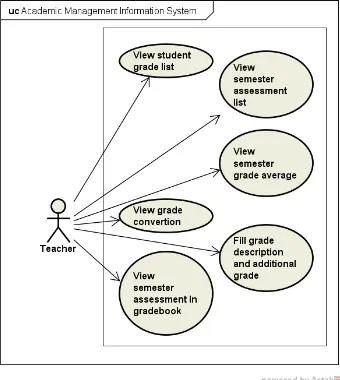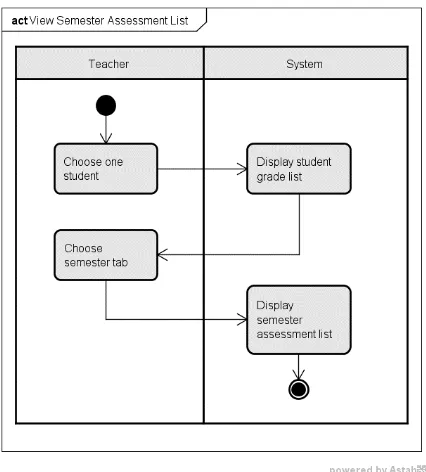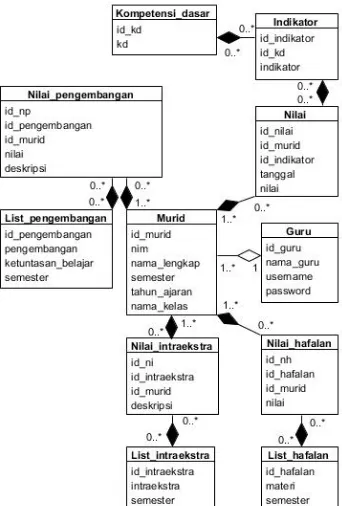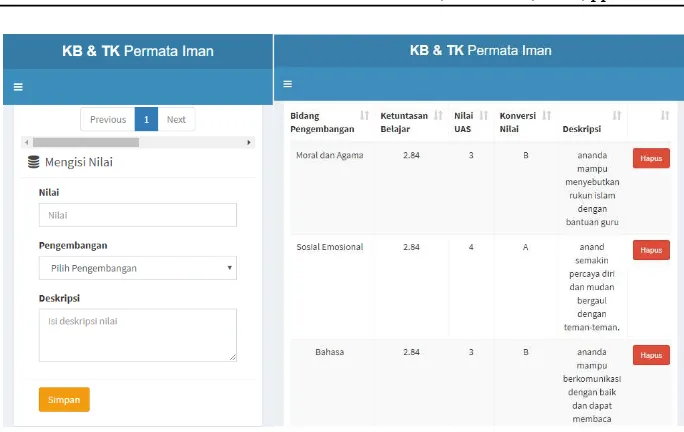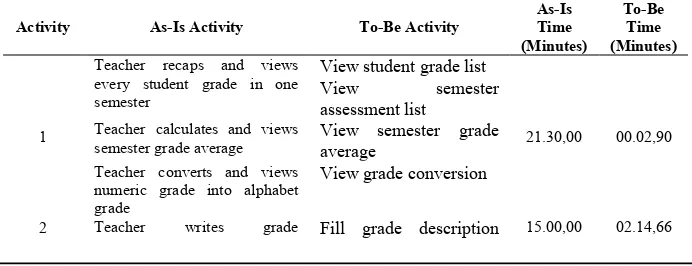Volume 3, Number 1, 2018, pp. 94-103 Journal Homepage: www.jitecs.ub.ac.id
Development of Academic Assessment Management
Information System (Case Study: KB & TK Permata Iman)
Firnanda Iftitah Dewi Antono1, Satrio Agung Wicaksono2, Aryo Pinandito3,
Computer Science Faculty, Brawijaya University, Malang, Jawa Timur, Indonesia
1
[email protected], [email protected], [email protected]
Received 06 August 2018; accepted 06 September 2018
Abstract. Education becomes an important thing to advance a nation. Therefore, everyone must follow the education level. One of education level is early childhood education. KB & TK Permata Iman which was established in 2005 is a private educational institution and focus on early childhood education. In learning evaluation, KB & TK Permata Iman still use conventional method. The conventional method takes much time because teachers need to collect daily grade until the end of a semester for final grade calculation and prepare the results in grade book. The semester learning evaluation process can be shortened and simplified using a web-based academic assessment management information system. The system can store, directly perform calculations when teachers add students’ grade and make grade book from saved grade. From the testing result, the time efficiency increased to 94.94% when evaluating semester learning using the system and it can help the teacher to save time and do another task.
1
Introduction
Education is one of the important factors to advance a nation and everyone supposed to follow the education level. Early childhood education is an education level before starting primary school and continuing to higher education level. Activities in early childhood education provide stimulation in accordance with the child development [1].
One of early childhood education organizations is KB & TK Permata Iman. KB & TK Permata Iman is an educational institution established in 2005. It became the first playgroup and kindergarten institution in Indonesia that was awarded ISO 9001:2000 certification. KB & TK Permata Iman is located in Malang City and has three branches in Tlogomas, Soekarno Hatta, and Sukun.
day. Parents should be able to observe the development of their kids to be able to do coaching in accordance with the material that is taught in school.
Currently, the technology is growing very rapidly. Various organizations and non-organizations have utilized information systems and other technologies. An information system generally is used to support the day-to-day work and organizational business processes [2]. In this modern era, the educational institution is supposed to follow the existing developments in its managerial and service. Therefore, an information system is needed in order to assist the learning evaluation.
The development of academic assessment management information system needed requirement specification by modeling the current business process and business process recommendation that can be drawn as user needs and modeled in the use case diagram. System design and system implementation were done with object-oriented approach. The advantages of object-object-oriented are reusable code and design, ease of system testing, and ease of maintenance when system requirements changed [3]. The information system was tested to show whether the existence of information systems can improve time efficiency of learning evaluation by comparing the time results before and after system existence.
The academic assessment management information system expected to improve time efficiency in the semester learning evaluation process. The system expected to be applied in KB & TK Permata Iman to support the semester learning evaluation process. In addition, this research also measured the impact of information system implementation on academic assessment business process efficiency, especially in KB & TK Permata Iman.
2
Related Work
Karno [4] explained the research they did has purposed to design and build a web-based information system to make manager easily get reports and other information from Science Techno Park activities. This research utilized an object-oriented approach to designing systems. Object orientated approach is a way of modeling software architecture so that it uses classes, objects, interfaces, abstractions, access rules, and patterns to describe a software solution. The time efficiency testing result showed that web-based information system is more efficient because it has a faster time than the manual.
Sanjani [5] explained that there is a problem when doing the salary calculation. The employee payroll information system was created as a solution to the problems at Rumah Sakit Bedah Surabaya. System design carried out by applying the object-oriented approach to facilitate further development. The built system proved that HRD department time efficiency is increased in doing the salary calculation process.
3 Methodology
3.1 Data Collection and Systems Requirement
Data collection was done using an interview technique and form gathering to obtain useful data during the research. Systems requirement is individual statements of conditions and capabilities to which the system must conform. One of systems requirement is functional requirements. Functional requirements describe what the system should do [7]. The functional requirements of the system are shown in Table 1.
Table 1. Functional Requirements Functional
Code
Functional Name
SKPL-F-01 View student grade list SKPL-F-02 View semester assessment list SKPL-F-03 View semester grade average SKPL-F-04 View grade conversion
SKPL-F-05 Fill grade description and additional grade SKPL-F-06 View semester assessment in grade book
3.2 Object-Oriented Design with UML
System design made by using an object-oriented approach (OO). System design includes use case diagram, sequence diagram, domain model class diagram, design class diagram, mapping class diagrams to a relational model, relational model normalization and interface design.
Use case diagram explains how users interact with the system and determine the steps needed to achieve a particular goal [8]. All functional requirements can be illustrated in the use case [9]. Figure 1 is a use case diagram of academic assessment management information system.
In use case diagram of the academic assessment management information system, there is 1 actor which is called teacher. It also has 6 use cases which are view student grade list, view semester assessment list, view semester grade average, view grade conversion, fill grade description and additional and also view semester assessment in grade book.
Activity diagram describes the dynamic actions of the system [9]. One of academic assessment management information system activity diagrams is viewing semester assessment list shown in Figure 2. The activity diagram of viewing semester assessment list is started when the teacher selects one of the students. Then, list of student grades is displayed. Furthermore, semester tab is selected and the assessment list for one semester will automatically be displayed by the system.
Fig. 2. Activity Diagram of Viewing Semester Assessment List of an Individual Student
Figure 3 is one of the sequence diagrams in academic assessment management information system called viewing semester assessment list. The sequence diagram of viewing semester assessment list is started when the teacher opens the dashboard page that will access the nilai() function in the dashboard controller with the id_murid parameter. The dashboard controller will access the nilai model to retrieve grade data for one semester which will be displayed to the actor using getNilai(id_murid) and getRataRataSemester(id_murid) functions. The semester tab is chosen to display the semester assessment list.
assessment management information system is shown in Figure 4. Figure 4 has 11
class which are guru, murid, nilai, nilai_hafalan, nilai_pengembangan,
nilai_intraekstra, list_hafalan, list_pengembangan, list_intraekstra, kompetensi_dasar and indikator.
Fig. 3. View Semester Assessment List Sequence Diagram
Fig. 4. Domain Model Class Diagram of Academic Assessment Management Information System
the development of academic assessment management information system, there are 16 classes which are divided into 5 controller classes and 11 model classes.
There are 11 tables from class diagram mapping to the relational database which are guru, murid, nilai, nama_hafalan, nilai_pengembangan, skor_intraekstra, list_hafalan, list_pengembangan, list_intraekstra, kompetensi_dasar, and indikator. Figure 5 describes the result of relational model. There are 2 additional tables which are kelompok and pembelajaran tables. The kelompok table contains a list of groups contained in KB & TK Permata Iman. The pembelajaran table provides information about a group of students and teachers.
Fig. 5. Relational Model of Academic Assessment Management Information System
3.3 Systems Implementation
The system was developed using PHP with Codeigniter framework that applies an object-oriented paradigm. After going through the design phase, the system was implemented. The system implementation of filling grade description and additional grade is shown in Figure 6. On the semester tab, the system displays the average semester scores based on each indicator and also the conversion results of each average.
3.4 Systems Testing
Systems testing was done in order to know if the system meets requirement that have been specified or not. Testing was done using black box testing and user time testing while accessing the system.
Fig. 6. Filling grade description and additional grade
Table 2. Black Box Testing Result
Requirement Type Functional Code Status
Functional Requirement
SKPL-F-01 Valid
SKPL-F-02 Valid SKPL-F-03 Valid SKPL-F-04 Valid SKPL-F-05 Valid SKPL-F-06 Valid
From the 6 functional requirements tested, the result is 100% valid. All functional requirements considered as valid because the system has no bug when doing the tasks. It is concluded that the system is running well and meet all the requirements that have been specified in Tabel 1.
To find out whether the academic assessment management information system can improve the time efficiency, it requires a user time testing. The user time testing was conducted by 4 KB & TK Permata Iman teachers. Table 3 is a test scenario conducted by the user to measure the needed time to complete the functionality of a business process using the built system.
Table 3. User Time Testing Scenario
Task Testing Procedure
View student grade list 1.The teacher chooses one student
2.The system displays student grade list who was chosen View semester assessment list 1.The teacher chooses one student
2.The system displays student grade list who was chosen 3.The teacher chooses tab semester
4.The system display semester assessment list
View semester grade average 1.The teacher chooses one student
4.The system displays student grade average based on the indicator in one semester
View grade conversion 1.The teacher chooses one student
2.The system displays student grade list who was chosen 3.The teacher chooses tab semester
4.The system displays grade conversion
Fill grade description and additional grade
1.The teacher presses the grade description and additional grade button
2.The system displays student additional grade list 3.The teacher fills additional grade based on category 4.The teacher presses save button
5.The system displays new additional grade list
View semester assessment in grade book
1.The teacher presses print grade book button 2.The system displays grade list in grade book
From the user time testing scenario, the user followed the testing procedures. The user time testing has been done by 4 teachers and the results are shown in Table 4. The average time for each task then calculated. View semester assessment list, view semester grade average and view grade conversion are in one page so the result time is same.
Table 4. User Time Testing Result
Task
View student grade list 00.01,72 00.01,50 00.01,15 00.01,98 00.01,59 View semester assessment list
00.01,91 00.01,10 00.01,11 00.01,10 00.01,31 View semester grade average
View grade conversion Fill grade description and
additional grade 02.08,62 02.07,94 02.00,24 02.41,82 02.14,66 View semester assessment in
grade book 00.02,75 00.00,83 00.01,60 00.01,55 00.01,68
4 Result and Discussion
The user time testing average compared to the time before system existence. The comparison of time results is shown in Table 5.
Table 5. Comparison of Semester Learning Evaluation Time
Activity As-IsActivity To-BeActivity
As-Is Teacher calculates and views
semester grade average
View semester grade average
Teacher converts and views numeric grade into alphabet grade
View grade conversion
description and additional for 3 as-is activities and 4 to-be activities summed into one in activity 1. The reason is that the view semester assessment list, view semester grade average and view grade conversion tasks are a series of processes. In addition, view semester assessment list is part of teacher recaps and views every student grade in one semester as-is activity.
The total time for the teacher to do semester learning evaluation before the system implemented is 1 hour 21 minutes 30 seconds. This is because the teacher recaps the daily grade, writes grade description and additional grade and also inputs student grade into grade book manually.
The total time needed by the teacher based on user time testing when using the system is 2 minutes 19 seconds 24 milliseconds for the semester learning evaluation process. With the information system, the grade recap for gradebook is performed automatically by the system. The grade does not need to be calculated and written on report cards one by one because the calculation and grade book making has been automated by the system. Figure 7 is a comparison chart of business process time before and after system existence.
Fig. 7. Comparison Chart of Business Process Time
The time efficiency increase value (E) is calculated from the as-is execution time (WA) and to-be execution time (Wt) with using Equation 1. Equation 1 is a general formula that is used to calculate the general difference in execution time between as-is and to-be.
Activity 1 Activity 2 Activity 3
Based on the results, there was an increase in the time efficiency to do semester learning evaluation. The time efficiency increased to 94.94% when evaluating semester learning using the system. In organizational perspective, the increased time efficiency can help the teacher to save time and do another task.
5 Conclusion
The semester learning evaluation process can be shortened, simplified and accelerated by using academic assessment management information system. Based on user time testing result, it can be seen that system existence was proven to improve the work efficiency of Permata Iman KB & TK teachers, especially when doing semester learning evaluation. The average of increased time efficiency is 94.94%.
References
1.Kementrian Pendidikan dan Kebudayaan Direktorat Jenderal Pendidikan Anak Usia Dini dan Pendidikan Masyarakat, https://paudni.kemdikbud.go.id/berita/739.html
2.Pinandito, A., Permana, F. B. P., Perdana, R. S.: Framework Design for Modular Web-based Application Using Model-CollectionService-Controller-Presenter (MCCP) Pattern. Journal of Information Technology and Computer Science, 2(1), pp. 41-65 (2017)
3.Mall, R.: Fundamentals of Software Engineering Fourth Edition. PHI Learning Private Limited, Delhi (2014)
4.Karno, Setyaningsih, T. B., Priswantoro, A.: Rancang Bangun Sistem Informasi Dokumentasi Kegiatan Science Techno Park Berbasis Web Pada Pusat Inovasi LIPI. Jurnal Teknologi Informasi dan Ilmu Komputer, 3(3), 174-179 (2016)
5.Sanjani, L. A., Hartati, S. J., Sudarmaningtyas, P.: Rancang Bangun Sistem Informasi Penggajian Pegawai dan Remunerasi Jasa Medis Pada Rumah Sakit Bedah Surabaya. Jurnal Sistem Informasi STIKOM Surabaya (JSIKA), 3(1), 87-93 (2014)
6.Fridayanthie, E. W., Charter, J.: Rancang Bangun Sistem Informasi Simpan Pinjam Karyawan Menggunakan Metode Object Oriented Programming (Studi Kasus: PT. Arta Buana Sakti Tangerang). Jurnal Techno Nusa Mandiri, 8(2), 63-71 (2016)
7.Sommerville, I.: Software Engineering Ninth Edition. Pearson, USA (2011)
8.Pressman, R. S.: Software Engineering A Practitioner’s Approach. The McGraw-Hill Companies, Inc., Amerika (2010)
9.Bittner, K., Spence, I.: Use Case Modeling. Addison Wesley, Boston. (2002)
10.Satzinger, J. W., Jackson, R. B., Burd, S. D.: Systems Analysis and Design in a Changing World, Sixth Edition. Course Technology, Boston (2012)
